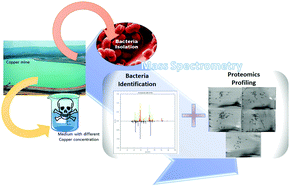Analysis of copper response in Acinetobacter sp. by comparative proteomics†
Abstract
Metal contamination exerts environmental pressure on several lifeforms. Since metals are non-biodegradable and recalcitrant, they accumulate in living beings and spread through the food chain. Thus, many life forms are affected by environmental metal contamination, such as plants and microorganisms. In the case of microorganisms, scarce information is available on how metals affect them. As a highly resistant form of life, microorganisms can adapt to several environmental pressures through genetic modifications, changing their metabolism to overcome new conditions, and continuing to thrive in the same place. In this study, an Acinetobacter sp. strain was isolated from a copper mine, which presented very high resistance to copper, growing in copper concentrations of up to 7 mM. As a result of its metabolic response in the presence of 3 mM of copper, the expression of 35 proteins in total was altered. The proteins were identified to be associated with the glycolytic pathway, membrane transport, biosynthesis and two proteins directly involved in copper homeostasis (CopA and CopB).



 Please wait while we load your content...
Please wait while we load your content...